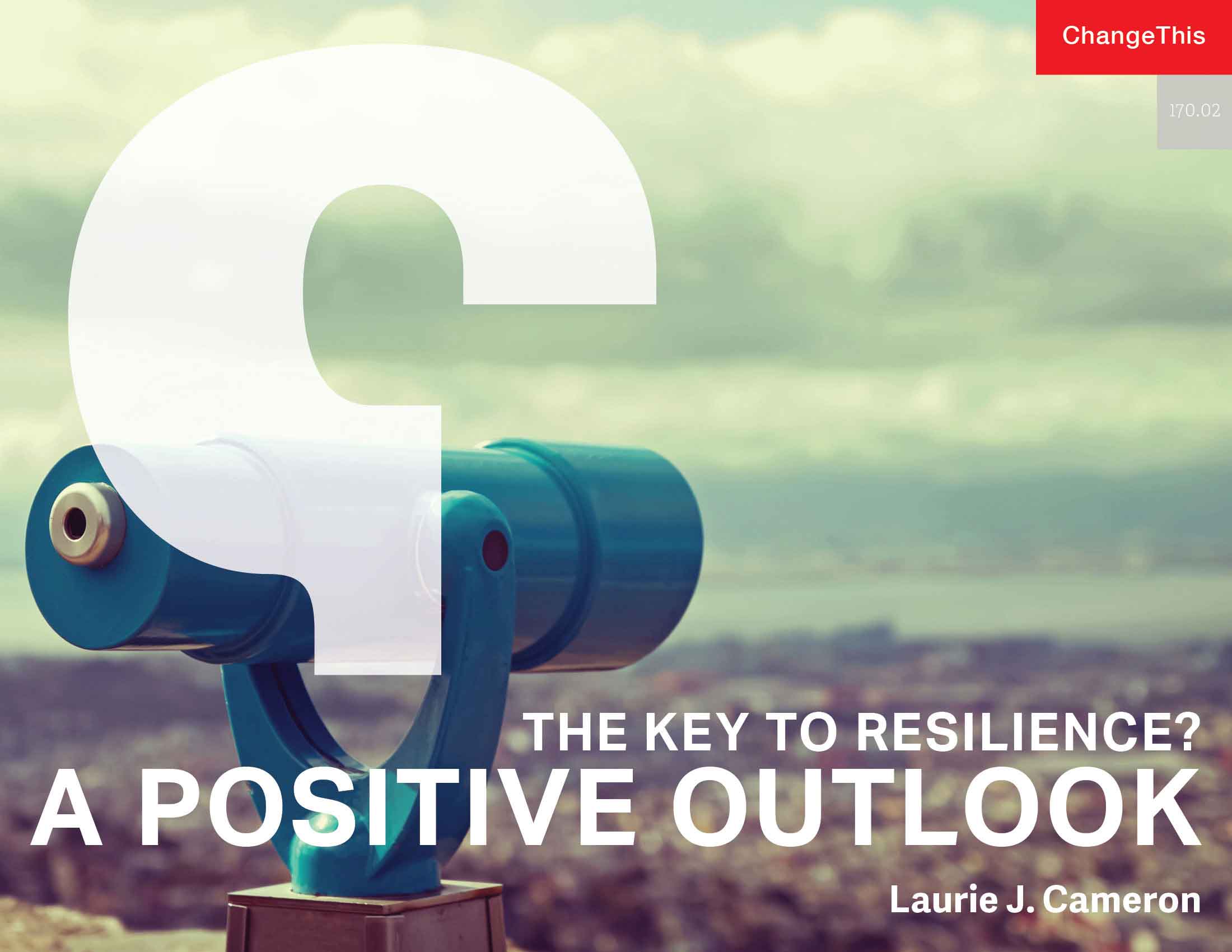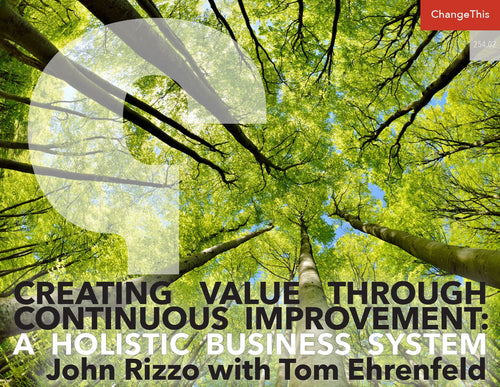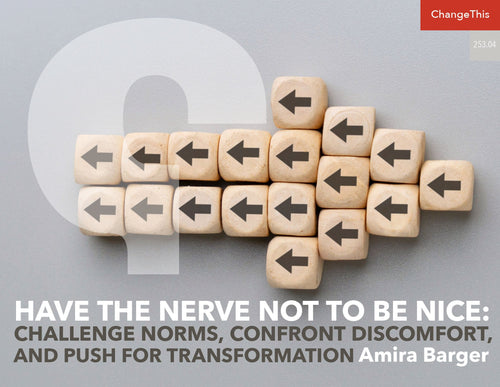The Key to Resilience? A Positive Outlook
In a recent podcast
of This American Life, I heard the story of Emir Kamenica. It started with his childhood in Sarajevo, running from gunfire, to immigrating to the US with his mother and sister and ending up with a family of his own as a professor in Chicago. Emir is known for being the happiest person around, despite the setbacks and hardships. And while the story was filled with unexpected turns and challenges overcome, what I found deeply compelling was what his wife revealed. The reason her husband is so happy “has to do with the way he filters the world around him, the way he decides not just what to think about, but how to think about it.” His wife Yelena says that she sees him do this all the time. He gets some news and “decides how to feel about that. It’s a practiced decision, but I still observe Emir making that decision. I’ve tried to crack that code by living with him.” She calls it the code of happiness. I call it the code of happiness with an additional benefit of resilience.
The key insight of Emir’s story is supported by a growing body of scientific research. Having a positive outlook in difficult circumstances is not only an important predictor of resilience— how quickly people recover from setbacks or adversity—but researchers suggest that it is the most important predictor of it.
Researchers find that people who are resilient tend to be more positive and optimistic compared to those who are less resilient. They are better able to regulate their emotions, and they are able to maintain their optimism through the most challenging situations.
Resilience, a positive outlook, and optimism are connected. So, is having a positive outlook something you are born with, or can it be developed?
Good news. A positive outlook can be cultivated with mindfulness. You can learn to choose your mindset and to shift how you relate to your experience, so that you have less stress and more joy. Mindfulness is a capacity that allows you to deliberately direct your attention towards the positive instead of being tossed around by random thoughts and turbulent emotions. What we see in stories of positive outlook and resilience is that the protagonists learn to “choose their story”—they develop the skill of directing their attention to the positive and making meaning of what happens by filtering it through a positive lens.
The poet and author Henry David Thoreau said it this way:
“To make a deep physical path, we walk again and again. To make a deep mental path, we must think over and over the kind of thoughts we wish to dominate our lives.”
Training Attention to Cultivate Positive States
Neuroscientist Richard Davidson of the Center for Healthy Minds at the University of Wisconsin at Madison suggests that it’s possible to train your attention. By focusing attention with intention, you can activate the regions associated with positive mental states of happiness, belonging, and well-being. With repeated mental exercises, you gradually condition your mind to tap into joy more often than fear. Inclining the mind means to condition yourself so that your mindsets shift from being judgmental, anxious, or uncomfortable to receptive, appreciative, and compassionate.
Offsetting the Negative with the Positive
Why take on the practice of training your mind toward the positive? To offset your evolutionary biology and incline your mind to the positive. Because your brain is designed for survival, over time, as your ancestors were dodging tigers and other dangers, the default circuitry became more attuned to the negative. We developed neural networks that continually look for, react to, store, and recall bad news. Yet what protected our ancestors can hinder us today. Neuropsychologist Rick Hanson explains that our brains are like Velcro for negative thoughts and Teflon for positive ones. This tendency to hold on to the negative is referred to as the negativity bias.
If you find that you cannot let go of a negative comment someone directed your way, or you replay one piece of constructive feedback from your manager among five positive ones, this is why. On top of that, we not only tune to the negative—we amplify it. It works like this: Our mind easily slips into worry. It ruminates on perceived threats, losses, mistreatment, and then our emotional reactions to them.
From there it spirals into self-deprecating thoughts of flaws, shortcomings, and mistakes, which in turn can kick up feelings of self-doubt. This primes us to be more anxious, untrusting, and irritable with others. If you ruminate about whether something you did in the past was “right,” and then start beating yourself up, you are not alone. You are human.
But there is something we can do. Our well-being depends on our ability to counteract this natural tendency to focus on the negative. Cultivating a mind tilted toward the positive takes sustained effort, yet our brains are wonderful, stunningly complex tools, and they can change and adapt—it’s that concept called neuroplasticity. You can use your mind to change your brain to change your mind. Whatever you repeatedly say and do changes the structure and the function of your brain. Your neural circuitry can adapt and form new connections into adulthood, upending the previous belief that neural growth is static after childhood.
The American psychologist William James said, “The greatest weapon against stress is our ability to choose one thought over another.” If you compensate for the brain’s bias by actively looking for and choosing the good, especially the little things that bring you joy, connection, and serenity, there is a payoff. You will feel happier, more peaceful, more open and caring toward others, and more motivated for action. When we focus on something, specific neurons fire together, and the more often they do so, the stronger the neural connections become. “Neurons that fire together wire together,” Hanson teaches. What you practice grows stronger. Your ability to pay attention to the positive and incline your mind toward greater well-being is within reach. Viktor Frankl, the Austrian psychologist who survived a concentration camp said it this way: “Everything can be taken from a man but one thing; the last of the human freedoms—to choose one’s attitude in any given set of circumstances, to choose one’s own way.”
Making Deposits for Lasting Effects
A positive mindset is how you filter and make sense of what you’re feeling, what you’re thinking, and how you’re approaching the world in terms of things that happen in the past, present, and future. Sustaining a positive mindset can be difficult—particularly during challenging situations— but it is attainable through positive mindful qualities that promote optimism, altruism, awe, and gratitude. How does this work? Positive emotions allow individuals to build up resources over time, like putting deposits in the emotional bank account. When stress hits, researchers believe you may be able to draw on these positive resource reserves.
There are other studies that support this idea. In a recent review of the research, Barbara Fredrickson and Thomas Joiner sum up the science to date: “Momentary experiences of mild, everyday positive emotions broaden people’s awareness in ways that, over time and with frequent recurrence, build consequential personal resources that contribute to their overall emotional and physical well-being.”
In the 2015 World Happiness Report, scientists Richard Davidson and Brianna Schuyler suggest four components of well-being supported by neuroscience: attention, outlook, resilience, and generosity. Each of these factors, they observe, are rooted in neural circuits that are subject to change—meaning that it’s possible to exercise these circuits to strengthen them. This is neuroplasticity at work. It’s a pretty profound idea that Davidson shared with us at a National Geographic talk in 2015: Well-being is a skill that we can develop with practice, preferably done in the morning to maximize effect throughout the day.
According to researchers Francesca Gino of the Harvard Business School and Adam Grant of the Wharton School at the University of Pennsylvania, practicing gratitude can have significant results on many dimensions: physical, psychological, and interpersonal. You will notice positive emotions like feeling happier, and helpful states like being alert and energetic. To amplify the gratitude payout, you can make a habit of waking up with a gratitude practice once a week—say every Saturday or every Sunday. A study by University of California, Riverside researcher Sonja Lyubomirsky revealed that a weekly gratitude practice is more powerful than a daily one.
What started as a set routine of mental training practices have now become a default way of waking up. On most mornings I start with a mindful breathing practice of following my inhale and exhale, then do a brief body scan - attending to each part of my body from the top of my head to my feet, and then a short loving-kindness practice- sending kind wishes to those I love, others in my life, and extend to those in wider and wider circles. On Sundays I do a gratitude practice, capturing what I am appreciating that week and writing it in my journal. I have noticed a shift in my mornings- they are uplifting and empowering—and there’s a ripple effect throughout the rest of the day. You can even experiment with a half-smile at the end of a few mindful breaths, as Thich Nhat Hanh suggests. Before you get out of bed, bring a half smile to your face, and notice the effect in your mind and body as you start your day.
Cultivating a positive outlook is not only highly beneficial for your personal well-being, but it is shown to be a factor in improving productivity, performance and joy in the workplace as well. Leaders influence culture and productivity by creating a positive culture. Kim Cameron, an organizational management professor and researcher, reveals in a study published in the Journal of Applied Behavioral Science that a workplace characterized by positive and virtuous practices excels in a number of domains. The positive principles include:
- Caring for, being interested in, and maintaining responsibility for colleagues as friends
- Providing support for one another, including offering kindness and compassion when others are struggling
- Avoiding blame and forgiving mistakes
- Inspiring one another at work
- Emphasizing the meaningfulness of the work.
- Treating one another with respect, gratitude, trust and integrity.
Positive organizational psychology not only has an impact on workplace productivity, it has also demonstrated to have a stronger impact than more traditional, logical methods, such as strategic planning, process redesign, inefficiency reduction or employee perks like on-site food, daycare, gyms, and flexible schedules. Leading with a positive mindset translates into engaged teams and thriving cultures.
Start Small and Savor the Good
At a retreat I attended early on my mindfulness journey, Zen master and teacher Thich Nhat Hanh observed that we are intentionally “watering the good seeds” of positivity when we engage in this way, rather than watering the negative seeds—both of which are present. He shared the simple but life-changing wisdom that the conditions for happiness are always available to us if we open ourselves to them, to choosing which neural pathways you want to strengthen. Instead of wondering when a situation will change or wishing an anticipated event would soon arrive, you need only to condition your mind to savor the joy that’s already there.
By delighting in micro-moments, you water the good seeds throughout the day—the feeling of tying your shoes before your morning run, the sun shining during an afternoon summer rain, or that surge of excitement and achievement when your team has a breakthrough idea. A friend in Miami snaps a photo every morning of the sunrise from his balcony, which is uniquely beautiful each day. My teaching partner in Sausalito captures the sunset on the West Coast.
What are the moments of joy in your own life? The more you start to notice, the more frequently the positive feelings are activated. Due to repeated practice and what we know about neuroplasticity, you will find that you are more inclined to the joyful and positive, changing your brain, your moment-to-moment experiences, and potentially, your life.
Take the reins in how you start your day by going to the mental gym. Find a quiet place to sit and pay attention to your breath for five minutes. Maintaining a regular meditation practice is one way that individuals might prioritize positivity within their daily routines explains Barbara Fredrickson and her colleagues in a recent study. Seven weeks after attending a mindfulness or loving kindness meditation workshop, participants felt more positive emotions than they had before. It makes sense that these two meditations may work to capture moments of positive emotions because mindfulness involves paying careful attention to the present moment and loving-kindness aims to self-generate warm and friendly feelings towards yourself and others.
Following a short meditation practice such as mindful breathing, choose a mental training exercise to incline your mind to the positive: It could be a simple version of the loving-kindness practice, where you are sending good wishes to others, or practices like “Take in the Good” where you pause and savor the good in the moment. Another practice you can try is to recall recent moments where you witnessed acts of compassion or generosity. When we pull up these acts into our awareness, it also generates positive feelings and cultivates well-being.
Six Steps to Cultivate Well-being
1. Settle your mind. First, arrive in the present moment. Be aware of your body, thoughts, and emotions as they are right now, wherever you are sitting, standing, or walking.
2. Start with breathing. Practice a few minutes of mindful breathing, which will soon become your go-to first step when pausing, relaxing the body, and directing your mind purposefully.
3. Gladden the heart. This variation of the loving-kindness practice is a brief way to counter feelings of being alone and generate the warm feeling of belonging. Bring to mind someone you love. You might picture the face of a child, partner, friend, or even a pet. Smile as you visualize and feel the love glowing back and forth between you and this person.
4. Loving-kindness for today. Practice loving-kindness specifically for the day ahead. As you think about what’s on your schedule, bring to mind each individual or group of people you will encounter. Then offer good wishes to each person or group by repeating the phrase: May you be healthy, may you be safe, may you be well, may you be happy. Do this for five minutes as a minimum effective dose—although you can expand this depending on what is on your agenda.
5. Take in the Good. Try a “Take in the Good” practice—and apply it to the roles you hold in your life. Appreciate the contribution you are making in the world. Where are you serving? Bring to mind a central commitment—whether it’s raising a child, supporting a business venture, or working on an art project. Ask yourself: What is going well in this role? How am I contributing to it? To install that sense of appreciation and let it take hold, spend at least 15 seconds thinking about your contribution.
6. See and savor joy. The practice of deliberately paying attention to the joyful moments in your life slowly starts to transform your day, and your life. Start in the morning, savoring the feel of a kiss on your cheek, noticing the wag of your dog’s tail, or marveling at the sunrise from your window. Make it a habit to savor joy throughout the day.










































